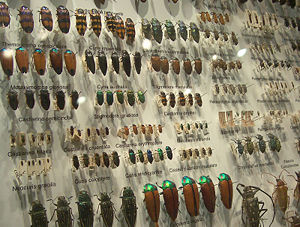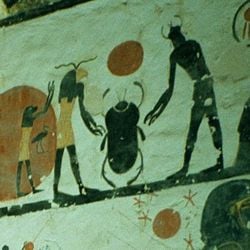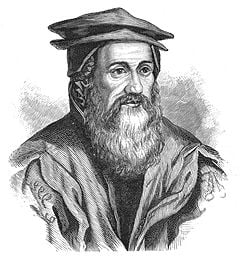Entomology
- Not to be confused with Etymology, the study of the origin of words.
Entomology is the scientific study of insects. Insects are arthropods (phylum Arthropoda) belonging to the Class Insecta. With around 925,000 described species, insects comprise the most numerous and diverse group of animals, representing more than half (about 57 percent) of all identified animal species.
Insects have many kinds of interactions with humans and other forms of life on earth, including key roles in food webs and nutrient recycling, in symbiotic relationships with flowering plants as pollinators, as producers of such human products like silk, honey, and shellac, and as agricultural pests and vectors of disease. Given these factors and the sheer numbers of insectsâcombined with a human nature endowed with curiosity and creativity and an often viewed role as stewards of natureâit is not surprising that entomology is an important specialty within biology.
Though technically incorrect, the definition of entomology is sometimes widened to include the study of terrestrial invertebrates in other arthropod groups or other phyla, such as arachnids, myriapods, earthworms, and slugs.
Applied entomology
Many entomologists are employed in the study of insects that are directly beneficial or harmful to humans. Beneficial insects include those that are pollinators of agricultural crops and ornamental flowers and those imported or otherwise vital as biological control agents. The study of beneficial insects is primarily focused on their ecology and life habits, the primary concern being the understanding of how to raise them and make them more productive, or protect them from human disturbance if they are native species such as wild bees.
Conversely, much of the study of insects (and related arthropods) that directly harm human beings or their domestic animals, called medical entomology and veterinary entomology, is focused on their physiology, with the goal of developing insect controls that are effective, while minimizing undesirable side effects. For instance, many types of insecticides have been developed that target unique aspects of insect physiology and are thus considered harmless to other kinds of animals. A risk to this approach is that insecticides can also kill beneficial insects. Considerable recent effort has gone into finding biological controls that are species-specific, such as species-specific parasites and diseases, as well as genetic controls, such as the introduction of sterile insects into a population. The combination of taking into account all aspects of insect biology, available control measures, economics, and environmental considerations is known as integrated pest management.
A few insects, chiefly blood-sucking Diptera, are vectors for a wide range of deadly diseases (Meyer 2003; Bowles and Swaby 2006). Mosquitoes are especially important disease vectors, with the genus Anopheles the principle vector of malaria, Aedes aegypti the main vector of yellow fever and dengue, and other Aedes spp. carrying the causal agents of various types of encephalitis (Meyer 2003). Other well-known vectors include the tsetse fly (genus Glossina transmits protozoan agents of African sleeping sickness), black flies (spread the parasitic roundworm Onchocerca volvulus, cause of onchoceriasis), and sand flies (genus Phlebotomus are vectors of bacteria that causes Carrion's disease, and sand flies are also agent of protozoans Leishmania spp. that cause Leishmaniasis) (Meyer 2003)
Forensic entomology specializes in the study of insect ecology for use in the legal system, as knowledge of insect behavior can yield useful information about crimes. For example, the approximate time of death or whether or not a victim was alive during a fire may be determined by using facts such as at what stage of life is an insect found at the scene.
Taxonomic specialization
Given the vast number and diversity of insects, many entomologists specialize in a single order or even a family of insects. A number of these subspecialties are given their own informal names, typically (but not always) derived from the scientific name of the group:
- Apiology (or melittology) - (study of) bees
- Coleopterology - beetles
- Dipterology - flies
- Heteropterology - true bugs
- Lepidopterology - moths and butterflies
- Myrmecology - ants
- Orthopterology - grasshoppers, crickets, etc.
- Trichopterology - caddis flies
Identification of insects
Insects other than Lepidoptera are typically identifiable only through the use of identification keys and monographs. Because the class Insecta contains a very large number of species, and the characters separating them are unfamiliar and often subtle (or invisible without a microscope), this is often very difficult even for a specialist.
Insect identification is an increasingly common hobby, with butterflies and dragonflies being the most popular.
History of entomology
With the vast numbers, diversity, and economic importance of insects, it is not surprising that entomology is rooted in nearly all human cultures from prehistoric times. However, scientific study only began as recently as the sixteenth century. Given the voluminous amount of informal and formal study of insects, only some brief overview of select key developments are presented in this section.
Early interest of humans in insects is shown in the rock painting of bees from approximately 13,000 B.C.E. Other early indicators include jewelry dated to about 1800 to 1700 B.C.E. from Crete depicting two golden bees holding a drop of honey; a painting around 1000 B.C.E. of a Scarab beetle on a wall of Rameses IX tomb; and a discussion of Ancient Egyptian beekeeping by Roman writers Virgil, Gaius Julius Hyginus, Varro, and Columella.
The first documented forensic entomology case is reported by Song Ci around 1250 C.E. in the medico-legal text book Xiyuan Jilu, where he describes the use of insects in the case of a stabbing near a rice field.
In 1551, zoologist Conrad Gesner published the first volume of Historia animalium (âHistory of Animalsâ), a work that includes some mention of insects.
In 1602, Ulisse Aldrovandiâs Animalibus insectis libri septem, cum singulorum iconibus AD vivum expressis was published. This work was devoted to the insects and some other invertebrates. More than a half-century later, between 1662 and 1667, Jan Goedart published Metamorphosis and historia naturalis, illustrating, by copper plate engravings, the metamorphosis of various insects.
In 1669, microscopist Jan Swammerdam published History of Insects, correctly describing the reproductive organs of insects and the process of metamorphosis. The same year the anatomist Marcello Malpighi published a treatise on the structure and development of the silkworm, the first description of the anatomy of an invertebrate. Shortly thereafter, from 1696 to 1700, Antonio Vallisneriâs Dialoghi will sopra the curiosa Origine di molti Insetti (in English, âDialogues on the curious origin of several insectsâ) is published; in this manuscript he, with Francesco Redi and Malpighi, contradicts the theory of spontaneous generation of maggots.
In the eighteenth century, three kinds of entomological text appeared. First, there were illustrative worksâshowy insects, often beautifully coloredâwhose purpose was sensual or aesthetic. An example is afforded by Maria von Merian's Metamorphosis Insectorum Surinamenis (âTransformations of the insects of Surinam,â 1705). It actually is a masterpiece of both art and science, and Merian, âthe mother of entomology,â was the first to record the full life cycle of many species of butterflies and moths.
Second, there were descriptive and systematic (classificatory) works, usually confined to what are now known as the Insecta. In 1710, there was the first attempt at a systematic classification of insect species with the publication of John Rayâs Historia insectorum in English. Almost half-a-century later, in 1758, Carolus Linnaeus published his groundbreaking work Systema Naturae, wherein the binomial nomenclature as the convention for the naming of organisms was popularized within the scientific community. In 1761, Jacob HĂŒbner (1761â1826), the first great world lepidopterist, was born. Before HĂŒbner, it was held that there were few genera of Lepidoptera (butterflies), a view he overthrew. His definitions of genera remain among the best of the time and so were his classifications. Also, in 1766, Moses Harris published The Aurelian or Natural History of English Insects, namely Moths and Butterflies. This was the first book on the British Lepidoptera (butterflies and moths). Harris was a pioneer in using wing venation in insect systematics. In 1771, Johann Reinhold Forster produced the first list of American insects.
A third category of entomological texts in the eighteenth century were works advancing various subdisciplines, such as developmental biology (life cycles), internal anatomy, physiology, and so on. These often covered other invertebrate groups. An example is RenĂ© Antoine Ferchault de RĂ©aumur's Memoires pour Servir a LâHistorie des Insectes.
In this century, a founding work of the scientific study of entomology was Jan Swammerdam's Biblia naturae or "Book of Nature," which was reissued in 1737.
From the beginning of the nineteenth century, the specialist began to predominate, harbingered by Johann Wilhelm Meigen's Nouvelle classification des mouches Ă deux aile ("New classification of the Diptera") in the first year of the century. Lepidopterists were among the first to follow Meigenâs lead. The specialists fell into three categories. First, there were species describers, then specialists in species recognition, and then specialists in gross taxonomy. There were, however, considerable degrees of overlap. Also, then, as now, few could entirely resist the lure of groups other than their own, and this was especially true of those in small countries where they were the sole 'expert', and many famous specialists in one order also worked on others. Hence, for instance, many works that began as butterfly faunas were completed as general regional works, often collaboratively.
In 1801, Jean Baptiste Pierre Antoine de Monet de Lamarck published SystÚme des Animaux sans VertÚbres ou Tableau Généraldes Classes des Ordres et des Genres de ces Animaux ("System of invertebrate animals or general table of classes, orders and genera of these animals"). The same year, Johann Christian Fabricius commenced a series of works in which he developed an insect classificatory system based entirely on the structure of the mouthparts. In Pisa, Italy, Pietro Rossi becomes the world's first professor of entomology.
In 1806, AndrĂ© Marie Constant DumĂ©rilâs Analitische Zoologie, published in both French and German, was an important text for its methodology and higher classification of insects.
Commenced in 1815 and completed in 1826, William Kirby and William Spenceâs Introduction to Entomology or Elements of the Natural History of Insects (4 vols., London: Longman) is a masterpiece that makes an outstanding contribution to entomology; it also was one of the most popular scientific works of all time.
In 1817, the pioneering work of American entomology, Thomas Say's American Entomology, is published in Philadelphia. In 1859, the Entomological Society of Philadelphia was established, later (1867) to be renamed the American Entomological Society. This is the earliest national organization in the biological sciences in the United States.
In 1871, Enrico Verson (1845-1927) founded the worldâs first silkworm experimental station in Italy.
In 1900, Walter Reed, a United States Army major, was appointed president of a board "to study infectious diseases in Cuba paying particular attention to yellow fever." He concurred with Carlos Finlay in identifying mosquitoes as the agent of transmission. In 1902, Ronald Ross was awarded the Nobel Prize for Medicine for his discovery that malaria is carried by mosquitoes. The awarding committee made special mention of the work of Giovanni Battista Grassi on the life history of the "Plasmodium" parasite (a protozoan that uses the mosquito as a host).
In 1934, Vincent B. Wigglesworth, the âFather of Insect Physiology,â wrote the first book on the subject, The Principles of Insect Physiology.
ReferencesISBN links support NWE through referral fees
- Carpenter, M. M. 1953. Bibliography of biographies of entomologists (Supplement). American Midland Naturalist 50(2): 257-348.
- Meyer, J. R. 2003. Insect vectors of human pathogens NC State University: College of Agriculture and Life Sciences. Retrieved January 15, 2008.
External links
All links retrieved February 13, 2024.
Credits
New World Encyclopedia writers and editors rewrote and completed the Wikipedia article in accordance with New World Encyclopedia standards. This article abides by terms of the Creative Commons CC-by-sa 3.0 License (CC-by-sa), which may be used and disseminated with proper attribution. Credit is due under the terms of this license that can reference both the New World Encyclopedia contributors and the selfless volunteer contributors of the Wikimedia Foundation. To cite this article click here for a list of acceptable citing formats.The history of earlier contributions by wikipedians is accessible to researchers here:
- Entomology history
- Timeline_of_entomology_-_prior_to_1800Â history
- Timeline_of_entomology_-_1800-1850Â history
- Timeline_of_entomology_-_1850-1900Â history
- Timeline_of_entomology_-_post_1900Â history
The history of this article since it was imported to New World Encyclopedia:
Note: Some restrictions may apply to use of individual images which are separately licensed.


